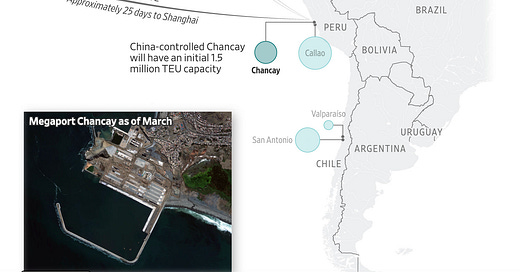Back in November, we reviewed the People’s Republic of China’s (PRC) new naval base in Cambodia. A few people poo-poo’d my and others’ concerns about it … but I’d love to ask them … what about something a lot closer?
While we spent a couple of decades in hubristic imperial policing actions on the other side of the planet, PRC was focused on the long - and more important game.
Here’s what happened while we basked in our lotus garden of entitled arrogance:
In this serene town on South America’s Pacific coast, China is building a megaport that could challenge U.S. influence in a resource-rich region that Washington has long considered its backyard.
The Chancay deep-water port, rising here among pelicans and fishermen in small wooden boats, is important enough to Beijing that Chinese leader Xi Jinping is expected to inaugurate it at the end of the year in his first trip to the continent since the pandemic.
Majority-owned by the giant China Ocean Shipping group, known as Cosco, Chancay promises to speed trade between Asia and South America, eventually benefiting customers as far away as Brazil with shorter sailing times across the Pacific for everything from blueberries to copper.
As nations around the world shudder at a new flood of cheap Chinese manufactured goods, the port could open new markets for its electric vehicles and other exports. China is already the top trade partner for most of South America.
No, it’s not a naval base - yet - but it is something even more important.
“This changes the game,” said Eric Farnsworth, a former high-ranking State Department diplomat who now leads the Washington office of the Council of the Americas think tank. “It really platforms China in a major new way in South America as the gateway to global markets. It is not just a commercial issue at that point, it is a strategic issue.”
Located 50 miles north of Peru’s capital, Lima, the $3.5 billion port—funded by Chinese bank loans—will be the first on South America’s Pacific coast able to receive megaships because of its nearly 60 feet of depth, though other ports in the region have large container-handling capacity. That will allow companies to send cargo on those vessels directly between Peru and China rather than on smaller ships that must go first to Mexico or California.
…
Peru’s Foreign Minister Javier González-Olaechea said that if the U.S. is concerned about China’s growing presence in Peru, then it should step up its own investments, adding that “everyone is welcome” to invest.
“The United States is present almost everywhere in the world with a lot of initiatives, but not so much in Latin America,” González-Olaechea said in an interview. “It’s like a very important friend who spends little time with us.”
Our Department of State and general national security nomenklatura has failed this nation from the Western Pacific to South and Central America. The amount of people who need to be invited to pursue excellence elsewhere is gobsmackingly large. They infested the DC decision making institutions for decades, layering error upon blinkered error, and yet are never held accountable … they just stay and remain attached to the bureaucracy ….
Do not discount what is going on in South America as just some commercial effort. Study your history … especially the history of empires.
Don’t forget, during the Cold War Peru was not a friend to the United States. Even after the Cold War, Peru was not to be trusted. Is she acting in accordance with USA national interests or even that of her neighbors?
Don’t bet on it. They are interested in Peru’s interests. What we’re failing to do is to help that needle point north and not west.







In my post-Navy life I’ve worked as a minerals-focused geologist. And I’ve traveled to Peru to do geological work. On the airliners down to Peru, it always seems that most of the people headed there from USA are tourists going to see sights/sites like Machu Picchu.
When I encounter Chinese in Peru - and I have encountered many! - they tend to be geologists. Indeed, the main rail line across the highest pass of the Peruvian Andes (yes, been there) serves a massive, Chinese-owned copper mine. Almost every car on this railway hauls nothing but Chinese-owned copper concentrate down to the coastline, and from there to the hold of a Chinese-owned cargo ship headed to China.
Nothing personal. Just business.